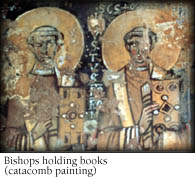The Emergence of the Canon
How the four gospels we know as the New Testament were chosen from dozens of versions of Jesus' story.By Marilyn Mellowes
 The New Testament, published in Christian Bibles used around the world,
contains 27 manuscripts or texts. The most prominent of these are the four
gospels known as Matthew, Mark, Luke and John. These texts are so familiar,
that it is easy to assume that four -- and only four -- gospels ever existed.
The New Testament, published in Christian Bibles used around the world,
contains 27 manuscripts or texts. The most prominent of these are the four
gospels known as Matthew, Mark, Luke and John. These texts are so familiar,
that it is easy to assume that four -- and only four -- gospels ever existed.
This is not the case, and the story of how the four gospels became chosen as part of the canon, or accepted literature of the church, offers a fascinating glimpse into the world of the early Christians.
Early Christian communities produced many gospels. One was the Gospel of Mary Magdalene, in which Mary is regarded as a disciple, a leader of a Christian group. Another early Christian text known as the Gospel of Truth, reflects on the teachings of Jesus, but does not talk about his death and resurrection; and the Gospel of Thomas contains only sayings attributed to Jesus.
As the number of Christian communities grew, so did the number and types of gospels. During the 2nd century, writing gospels became practically a "cottage industry," for the audience and the appetite for the literature seemed unlimited.
But there were those who felt a need to place some boundaries on the proliferation of gospels. Among them was Irenaeus, who became the bishop of Lyon, after the Christian community there had suffered a devastating persecution. For Irenaeus, the survival of the church was linked to the necessity for order.
That order extended to the texts that Christians used in their worship. In about the year 180 CE, Irenaeus suggested that the proper number of gospels was four. He invoked a curious logic: there are four corners to the earth, there are four winds, there are four beasts of the apocalypse.
Irenaeus himself did not have the authority to simply impose this limitation to four gospels. But it seems that many church officials were sympathetic to his perceived need to reign in diversity. As Allen Callahan points out, it is easy to stereotype the arbitrary quality of the decision-making process: "a bunch of cigar smoking Christian big shots got together, and they decided who was going in and who was going out. It was a wrap, they closed up, and taken everything else was on the cutting room floor and the janitors took away what didn't get in the Canon."
But Callahan suggests that the choice of these four gospels reflects the preferences and practices of a growing majority of early Christian communities. There was a rough consensus about "literature that they want to read, that they want to hear over and over again. And other kinds of literature that they don't want to hear."
The canon imposed limits, but it also preserved a measure of diversity. As Helmut Koester has observed: "There is no claim that this canon represents four gospels that are all saying the same thing. It is rather an attempt to bring together as many Christian communities as possible into one major church."
The four gospels reflect diversity, yet they all share one key element: each tells the story of passion of Jesus, his suffering and his death. That story is intimately connected to the ritual that is the centerpiece of Christian worship, the celebration of the Eucharist, the Last Supper. Story and ritual are deeply connected. As Koester has observed, the ritual cannot live without the story. And, in the worship of the emerging church, the story was sustained and deepened by the ritual.
